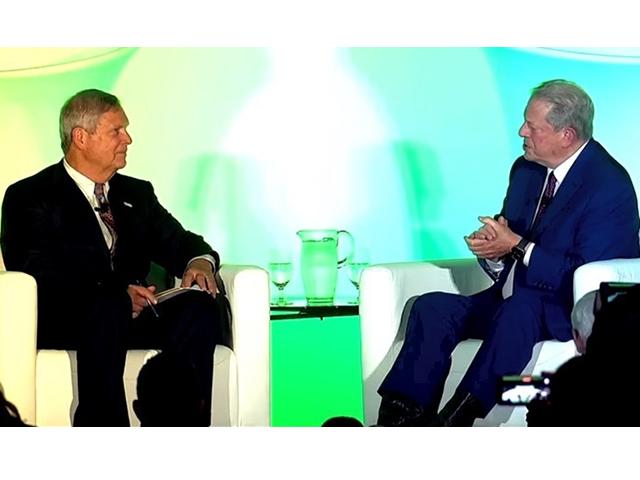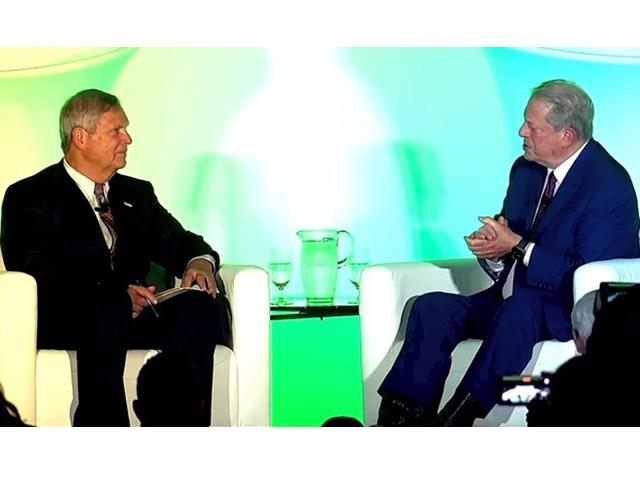Ag Policy Blog
At AIM Summit, Gore Talks About His Farm, Carbon Sequestration and Fossil Fuels
WASHINGTON (DTN) -- Agriculture Secretary Tom Vilsack on Monday opened the Agriculture Innovation Mission (AIM) for Climate Summit in Washington, welcoming hundreds of attendees, including many from other countries, to an event set up to increase and accelerate investment in and support for agriculture and food systems innovation for climate action.
Vilsack, who launched the AIM for Climate initiative at the 26th United Nations Climate Change Conference (COP26) in November 2021, is co-hosting the event with Mariam bint Mohammed Almheiri, the minister of climate change and environment in the United Arab Emirates (UAE), the lead partner with the United States in the AIM initiative.
In an interview conducted by Vilsack, former Vice President Al Gore, who is known for the book and film "An Inconvenient Truth," began his presentation at the summit talking about his farm in Tennessee.
Gore said he began about 10 years ago transforming the farm into regenerative agriculture.
Gore said planting more trees is a good idea but the best way to preserve carbon in the soil is in farming. Soil carbon sequestration through regenerative agriculture is the single best way to take carbon out of the atmosphere, Gore said.
He also said that if farmers are going to remove carbon from the atmosphere they ought to be compensated, but in order to do that ways must be found to accurately measure that carbon that is put back in the soil. He noted that his own farm is working on developing accurate measurement.
His advice to the livestock industry is to feed the animals seaweed, which reduces the amount of methane they emit.
Vilsack noted Gore has an investment firm called Generation Investment Management with offices in London and San Francisco. One of its investments is PivotBio.
To people who become discouraged about addressing climate change, Gore said, "Political will is a renewable resource."
In less than two years, Vilsack said the AIM for Climate initiative has attracted more than 500 partners, including 50 governments, that together have promised to invest $13 billion in climate-smart agriculture and food systems innovation. The initiative includes "innovation sprints" to try to develop climate-smart innovations quickly.
Policymakers, industry leaders, producers, civil society groups, and scientists and researchers are attending the summit "to drive rapid and transformative climate action," according to the USDA AIM for Climate website.
P[L1] D[0x0] M[300x250] OOP[F] ADUNIT[] T[]
"Climate change continues to impact longstanding agricultural practices in every country and a strong global commitment is necessary to face the challenges of climate change head-on and build more sustainable, equitable, and resilient food systems," Vilsack said.
"We need all of us working together to address the challenges of climate change and food security through innovative technology and approaches, and the AIM for Climate Summit gives me hope that we will rise to the occasion, as future generations depend on us to do."
Almhieri said, "The AIM for Climate Initiative, launched in collaboration between the UAE and the United States, embodies this important approach, reflecting our commitment to transforming global agricultural systems into more advanced and sustainable systems to confront the scarcity of water and arable land in many countries, and thereby contributing to the eradication of hunger in the world."
Vilsack announced the release of the "USDA Science and Research Strategy, 2023-2026: Cultivating Scientific Innovation" during the opening plenary.
This strategy drives USDA's science priorities for the next three years to establish a scientific framework to transform the U.S. food system and support the nation's farmers, ranchers, producers, and foresters.
"We know that scientific innovation can enable new, cost-effective solutions for addressing some of our most daunting challenges," said Vilsack. "This is a forward-looking strategy that aligns with USDA's strategic priorities and allows us to make significant advances in food, agriculture and natural resource sectors."
The strategy's five science and research priorities are:
- Accelerating Innovative Technologies & Practices
- Driving Climate-Smart Solutions
- Bolstering Nutrition Security & Health
- Cultivating Resilient Ecosystems
- Translating Research into Action
Vilsack also announced the launch of the International Climate Hub website.
"This new portal will enable science-based, climate-informed agricultural decision making by providing information and resources tailored to specific regions and needs, including a focus on the countries and producers most vulnerable to the effects of global climate change," Vilsack said.
The summit continues through Wednesday.
AIM for Climate Summit https://web.cvent.com/…
USDA Science and Research Strategy 2023-2026 https://www.usda.gov/…
Former US Vice President Al Gore speaks about climate-smart agriculture (video link) https://www.youtube.com/…
Jerry Hagstrom can be reached at jhagstrom@nationaljournal.com
Follow him on Twitter @hagstromreport
(c) Copyright 2023 DTN, LLC. All rights reserved.






Comments
To comment, please Log In or Join our Community .